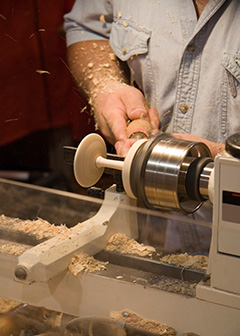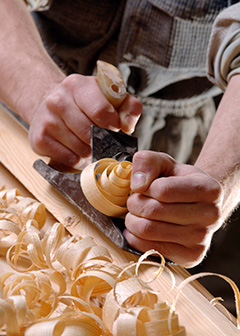
Woodworkers measure finished products for imperfections.
Woodworkers build a variety of products, such as cabinets and furniture, using wood.
Duties
Woodworkers typically do the following:
- Read detailed schematics and blueprints
- Prepare and set up equipment
- Lift wood pieces onto machines, either by hand or with hoists
- Operate wood-making and cutting machines
- Listen for unusual sounds or detect excessive vibration
- Ensure that products meet specifications, making adjustments as necessary
- Use hand tools to trim pieces or assemble products
- Remove and replace dull saw blades
Despite the abundance of plastics, metals, and other materials, wood products continue to be an important part of our daily lives. Woodworkers make wood products, using lumber and synthetic wood materials. Many of these products are mass produced, including most furniture, kitchen cabinets, and musical instruments. Other products are custom made with specialized tools in small shops.
Although the term “woodworker” may evoke the image of a craftsman who builds ornate furniture using hand tools, the modern woodworking trade is highly technical and relies on advanced equipment and highly skilled operators. Workers use automated machinery, such as computerized numerical control (CNC) machines, to do much of the work.
Even specialized artisans generally use a variety of power tools in their work. Much of the work is done in a high-production assembly line facility, but there is also some work that is customized and does not lend itself to being made in an assembly line. Woodworkers are employed in every part of the secondary wood products industry, from sawmill to finished product, and their activities vary.
Woodworkers set up, operate, and tend all types of woodworking machines, such as drill presses, lathes, shapers, routers, sanders, planers, and wood-nailing machines. Operators set up the equipment, cut and shape wooden parts, and verify dimensions, using a template, caliper, and rule. After wood parts are made, woodworkers add fasteners and adhesives and connect the pieces to form a complete unit. They then sand, stain, and, if necessary, coat the wood product with a sealer, such as a lacquer or varnish.
Many of these tasks are handled by different workers with specialized training.
The following are types of woodworkers:
Cabinetmakers and bench carpenters cut, shape, assemble, and make parts for wood products. They often design and create sets of cabinets that are customized for particular spaces. In some cases, their duties begin with designing a set of cabinets to specifications and end with installing them.
Furniture finishers shape, finish, and refinish damaged and worn furniture. They often work with antiques and must judge how to best preserve and repair them. They also do the staining and sealing at the end of the process of making wooden products.
Wood sawing machine setters, operators, and tenders specialize in operating specific pieces of woodworking machinery. They often operate computerized numerical control (CNC) machines.
Woodworking machine setters, operators, and tenders, except sawing, operate woodworking machines, such as drill presses, lathes, routers, sanders, and planers.









